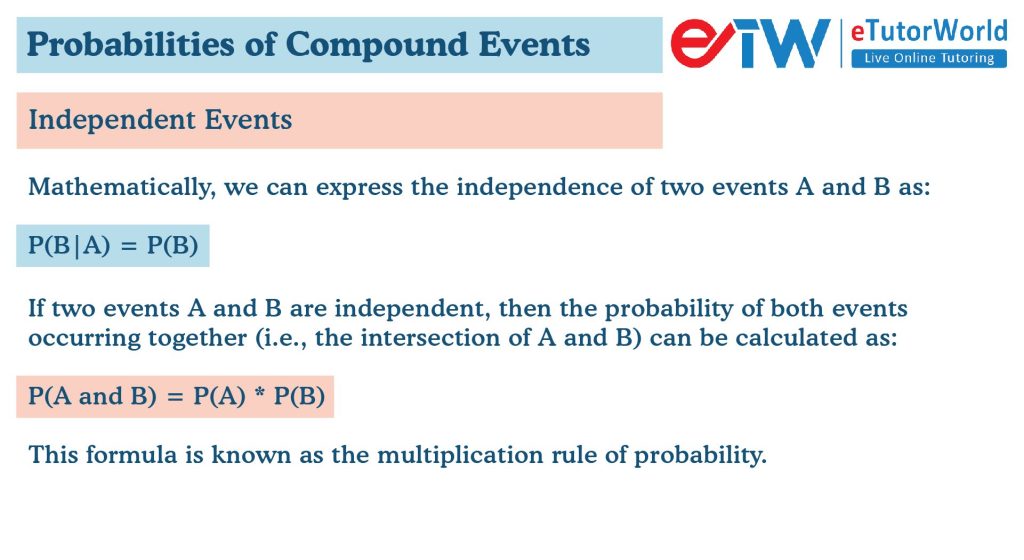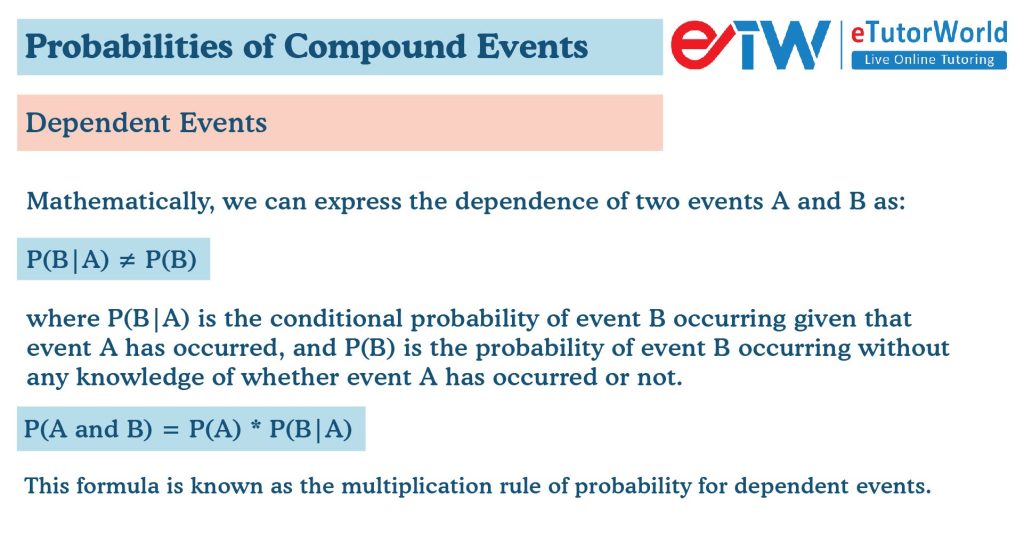Probabilities of Compound Events
Grade 7 Math Worksheets
In probability theory, a compound event refers to an event that can be described in terms of two or more simpler events.
Table of Contents:
- Probabilities of Compound Events
- Independent Events
- Dependent Events
- FAQs
Personalized Online Tutoring
Probabilities of Compound Events - Grade 7 Math Worksheet PDF
This is a free worksheet with practice problems and answers. You can also work on it online.
Sign up with your email ID to access this free worksheet.
"We really love eTutorWorld!"
"We really love etutorworld!. Anand S and Pooja are excellent math teachers and are quick to respond with requests to tutor on any math topic!" - Kieran Y (via TrustSpot.io)
"My daughter gets distracted easily"
"My daughter gets distracted very easily and Ms. Medini and other teachers were patient with her and redirected her back to the courses.
With the help of Etutorworld, my daughter has been now selected in the Gifted and Talented Program for the school district"
- Nivea Sharma (via TrustSpot.io)
Probabilities of Compound Events
In probability theory, a compound event refers to an event that can be described in terms of two or more simpler events. The probability of a compound event can be calculated using the rules of probability, which depend on whether the events are independent or dependent.

Independent events: Two events are independent if the occurrence of one event does not affect the probability of the other event occurring. The probability of two independent events A and B occurring is given by:
P(A and B) = P(A) * P(B)
where P(A) is the probability of event A occurring and P(B) is the probability of event B occurring.
For example, the probability of rolling a 3 on a die and flipping a coin and getting heads is:
P(3 and heads) = P(3) * P(heads) = (1/6) * (1/2) = 1/12
Dependent events: Two events are dependent if the occurrence of one event affects the probability of the other event occurring. The probability of two dependent events A and B occurring is given by:
P(A and B) = P(A) * P(B|A)
where P(B|A) is the conditional probability of event B occurring given that event A has occurred.
For example, the probability of drawing two cards from a deck of cards and getting a king and then a queen (without replacement) is:
P(king and queen) = P(king) * P(queen|king) = (4/52) * (4/51) = 16/2652
These are just two examples of how to calculate the probabilities of compound events. The rules of probability can be extended to more complex scenarios involving multiple events, such as the probability of rolling a certain combination of numbers on two dice or the probability of getting a certain hand in a game of poker.
Independent Events
In probability theory, two events A and B are independent if the occurrence of one event does not affect the probability of the other event occurring. In other words, the probability of event B occurring given that event A has occurred is the same as the probability of event B occurring without any knowledge of whether event A has occurred or not.

Mathematically, we can express the independence of two events A and B as:
P(B|A) = P(B)
where P(B|A) is the conditional probability of event B occurring given that event A has occurred, and P(B) is the probability of event B occurring without any knowledge of whether event A has occurred or not.
If two events A and B are independent, then the probability of both events occurring together (i.e., the intersection of A and B) can be calculated as:
P(A and B) = P(A) * P(B)
This formula is known as the multiplication rule of probability.
For example, suppose we have two coins that we flip simultaneously. The probability of getting heads on the first coin is 1/2, and the probability of getting heads on the second coin is also 1/2. Since the two events (i.e., getting heads on the first coin and getting heads on the second coin) are independent, the probability of getting heads on both coins is:
P(heads on both coins) = P(heads on first coin) * P(heads on second coin) = (1/2) * (1/2) = 1/4
This means that there is a 1/4 chance of getting heads on both coins when we flip them simultaneously.
Examples of Independent Events
Here are some examples of independent events:
Flipping a coin: The outcome of one flip of a coin does not affect the outcome of any other flip. Therefore, each flip of the coin is an independent event.
Rolling a die: Similarly, the outcome of one roll of a die does not affect the outcome of any other roll. Therefore, each roll of the die is an independent event.
Drawing cards from a deck: If a card is drawn from a deck of cards and not replaced, then the probability of drawing a certain card on the second draw depends on what card was drawn on the first draw. However, if the card is replaced after each draw, then the draws are independent events.
Tossing two coins: When two coins are tossed simultaneously, the outcome of one coin toss does not affect the outcome of the other coin toss. Therefore, each coin toss is an independent event.
Weather conditions: The temperature and precipitation on one day do not affect the temperature and precipitation on any other day. Therefore, the weather conditions on different days can be considered independent events.
In each of these examples, the outcome of one event does not affect the outcome of the other event, so the events are considered to be independent.
“There have been times when we booked them last minute, but the teachers have been extremely well-prepared and the help desk at etutorworld is very prompt.
Our kid is doing much better with a higher score.”
7th Grade Tutoring
eTutorWorld offers Personalized Online Tutoring for Math, Science, English, and Standardised Tests.
Our Tutoring Packs start at just under $22.49 per hour, and come with a moneyback guarantee.
Schedule a FREE Trial Session, and experience quality tutoring for yourself. (No credit card required.)
Dependent Events
In probability theory, two events A and B are dependent if the occurrence of one event affects the probability of the other event occurring. In other words, the probability of event B occurring depends on whether event A has occurred or not.

Mathematically, we can express the dependence of two events A and B as:
P(B|A) ≠ P(B)
where P(B|A) is the conditional probability of event B occurring given that event A has occurred, and P(B) is the probability of event B occurring without any knowledge of whether event A has occurred or not.
If two events A and B are dependent, then the probability of both events occurring together (i.e., the intersection of A and B) can be calculated as:
P(A and B) = P(A) * P(B|A)
This formula is known as the multiplication rule of probability for dependent events.
For example, suppose we have a bag of marbles with 3 red marbles and 2 blue marbles. If we draw one marble from the bag without replacing it, the probability of drawing a red marble on the first draw is 3/5. If we then draw a second marble from the bag without replacing the first marble, the probability of drawing a red marble on the second draw depends on whether the first marble was red or blue.
If the first marble was red, then there are only 2 red marbles left out of a total of 4 marbles, so the probability of drawing a red marble on the second draw is 2/4 = 1/2. If the first marble was blue, then there are still 3 red marbles left out of a total of 4 marbles, so the probability of drawing a red marble on the second draw is 3/4. Therefore, the probability of drawing two red marbles in a row is:
P(red on both draws) = P(red on first draw) * P(red on second draw|red on first draw)
= (3/5) * (2/4) + (2/5) * (3/4) = 6/20 = 3/10
This means that there is a 3/10 chance of drawing two red marbles in a row from the bag.
Examples of Dependent Events
Here are some examples of dependent events:
Drawing cards from a deck without replacement: If a card is drawn from a deck of cards and not replaced, then the probability of drawing a certain card on the second draw depends on what card was drawn on the first draw. If the first card drawn is a king, then there are fewer kings in the deck for the second draw, so the probability of drawing another king is reduced. Therefore, the draws are dependent events.
Choosing socks from a drawer: Suppose you have a drawer with 6 pairs of socks, where each pair has a different color. If you choose one sock at random, the probability of choosing a blue sock is 1/6. However, if you then choose a second sock without replacing the first, the probability of choosing another blue sock is reduced, since there is now one fewer blue sock in the drawer. Therefore, the choices are dependent events.
Taking medication: If you take a medication that has a side effect of drowsiness, then the probability of experiencing drowsiness depends on whether you take the medication or not. If you do not take the medication, then you will not experience the side effect. Therefore, the events are dependent.
Testing positive for a disease: The probability of testing positive for a disease depends on whether you have the disease or not. If you have the disease, then the probability of testing positive is higher than if you do not have the disease. Therefore, the events are dependent.
In each of these examples, the probability of one event depends on whether another event has occurred or not, so the events are considered to be dependent.
Do You Stack Up Against the Best?
If you have 30 minutes, try our free diagnostics test and assess your skills.
FAQS
What is a compound event?
A compound event is an event that consists of two or more simple events. For example, rolling a die and getting an even number is a compound event because it consists of the simple events of rolling a 2, 4, or 6.
How do you calculate the probability of a compound event?
To calculate the probability of a compound event, you can use the addition rule or the multiplication rule, depending on whether the events are independent or dependent. If the events are independent, you can use the addition rule to add the probabilities of the individual events. If the events are dependent, you can use the multiplication rule to multiply the probabilities of the individual events.
What is the addition rule of probability?
The addition rule of probability states that the probability of either of two mutually exclusive events occurring is the sum of their individual probabilities. For example, the probability of rolling a 1 or a 2 on a six-sided die is 1/6 + 1/6 = 1/3.
What is the multiplication rule of probability?
The multiplication rule of probability states that the probability of two or more independent events occurring together is the product of their individual probabilities. For example, the probability of rolling a 2 and then rolling a 4 on a six-sided die is (1/6) * (1/6) = 1/36.
What is the difference between independent and dependent events?
Two events are independent if the occurrence of one event does not affect the probability of the other event occurring. Two events are dependent if the occurrence of one event affects the probability of the other event occurring.

Gloria Mathew writes on math topics for K-12. A trained writer and communicator, she makes math accessible and understandable to students at all levels. Her ability to explain complex math concepts with easy to understand examples helps students master math. LinkedIn
Affordable Tutoring Now Starts at Just $22.49
eTutorWorld offers affordable one-on-one live tutoring over the web for Grades K-12. We are also a leading provider of Test Prep help for Standardized Tests (SCAT, CogAT, MAP, SSAT, SAT, ACT, ISEE, and AP).
What makes eTutorWorld stand apart are: flexibility in lesson scheduling, quality of hand-picked tutors, assignment of tutors based on academic counseling and diagnostic tests of each student, and our 100% money-back guarantee.
Whether you have never tried personalized online tutoring before or are looking for better tutors and flexibility at an affordable price point, schedule a FREE TRIAL Session with us today.
*There is no purchase obligation or credit card requirement
Grade 7 Science Worksheets
- Elements and Compounds
- Solar Energy
- Photosynthesis
- Electricity and Magnetism
- Law of conservation of energy
- Periodic table
- Properties of Matter
- Waves
- Energy Resources
- Weather and Climate
- Immune, Circulatory and Digestive Systems
- Organs in Multi-cellular Organism
- Sedimentary, Igneous, and Metamorphic Rocks
- Structure of the Earth
- Law of Conservation of Mass
- Physical and Chemical Changes
- Scientific Method
- Human Digestive System
- Environmental Science
- Renewable and Non-renewable energy Resources
- Characteristics of Living Organisms
- Life Science
- Earth and Space Science
- Solar Eclipse
- Heat Technology
- Newton’s Laws of Motions
- Physical Science
- Tools, Measurement and SI Units
- Earth Atmosphere
- Interactions of Living things
- The Earth Ecosystem
- Organelles in Plant and Animal cells
- Layers of the Earth
- Cycles in Nature
Grade 7 Math Worksheets
- Fractions
- Linear equations word problems
- Statistics
- Properties of Parallel Line
- Finding slope from an equation
- Identifying Quadrilaterals
- Percent Change
- Properties of addition and multiplication
- Pythagorean Theorem
- Solving two step inequalities
- Symmetry
- Fractions to Decimals (New)
- Whole Number Exponents with Integer Bases (New)
- Adding and Subtracting Fractions (New)
- Integer Addition and Subtraction (New)
- Dividing Mixed Numbers (New)
- Basics of Coordinate Geometry (New)
IN THE NEWS

Our mission is to provide high quality online tutoring services, using state of the art Internet technology, to school students worldwide.
Online test prep and practice
SCAT
SSAT
ISEE
PSAT
SAT
ACT
AP Exam
Science Tutoring
Physics Tutoring
Chemistry Tutoring
Biology Tutoring
Math Tutoring
Pre-Algebra Tutoring
Algebra Tutoring
Pre Calculus Tutoring
Calculus Tutoring
Geometry Tutoring
Trigonometry Tutoring
Statistics Tutoring
Quick links
Free Worksheets
Fact sheet
Sales Partner Opportunities
Parents
Passive Fundraising
Virtual Fundraising
Our Expert Tutors
Safe and Secure Tutoring
Interactive Online Tutoring
After School Tutoring
Elementary School Tutoring
Middle School Tutoring
High School Tutoring
Home Work Help
Math Tutors New York City
Press
©2022 eTutorWorld Terms of use Privacy Policy Site by Little Red Bird
©2022 eTutorWorld
Terms of use
Privacy Policy
Site by Little Red Bird









